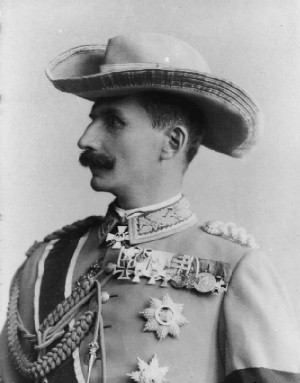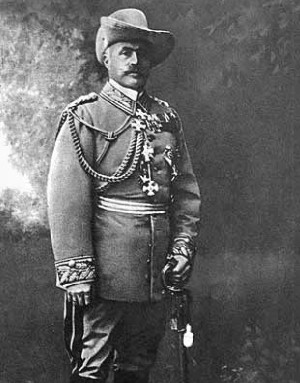| Period Photographs
of the Home Uniform for Schutztruppe Generals |
|

Generalmajor Eduard von
Liebert
Commander of the East African Schutztruppe 1897-1901
Photograph from
WikiCommons |

Generalleutnant Lothar von Trotha
Commander of the South West African Schutztruppe 1904-06
Photograph from
WikiCommons |

Generalmajor Wilhelm
Müller c1908
Commander of the Cameroon Schutztruppe 1903-08
Photograph Bundesarchiv /
WikiCommons |
All three photographs show
Schutztruppe generals wearing their full home uniform. Note the
embroidered Litzen on the collar and cuffs, twisted left shoulder
strap and braided right, the yellow metallic lace hatbands and
edging, the twelve buttons going right down the the bottom
edge of the tunic with the last four undone, the two broad red striped on the trousers and
the impressive medal display that each general
wears.
Brief Biographies of the Eight
Schutztruppe Generals
Theodor
Leutwein (1849-1921) served as a Leutnant in the 113th Baden
Infantry ("5. Badischen
Infanterie-Regiment Nr.113")
from 1869. In 1893 as Major he was posted to South West Africa and
the following year
replaced Curt von François as Landeshauptmann (effectively the
governor) of South West Africa and commander of the Schutztruppe. In 1898 the title of Landeshauptmann was officially replaced
by "Gouverneur". While in Africa he was promoted to
Oberst. During his time in office he devised and followed a
policy of appeasement with the local tribes backed up with armed
threats. His aim was to pacify both the Nama and the Herero avoiding
military action where possible. When the Herero Rebellion broke out
in 1904 he was unprepared and although his Schutztruppe managed to
contain the rebels they could not be defeated. Leutwein was sent
back to Germany and replaced by the more ruthless Lothar von Trotha.
In retirement he was promoted to Generalmajor and wrote his memoirs, published in 1906 as "Elf Jahre als Gouverneur in Deutsch-Südwestafrika".
Lothar von Trotha (1848-1920)
who had served in the 2nd Prussian Foots Guards ("2. Garderegiment zu Fuß") during the Austro-Prussian
War and
in the 47th Electoral Hessen Infantry ("1. Kurhessischen
Infanterie-Regiment Nr. 47.") during the Franco-Prussian War, when
he was wounded at the Battle of Worth and earned the Iron Cross. He
was promoted to Premierleutnant in 1873, Hauptmann in 1877, Major in
1888 and as Oberstleutnant in 1896 commanded the Schutztruppe of
German East Africa for a year. Further promotion followed back in
Germany and in 1900 he commanded the 1st East Asian Infantry Brigade
as Generalmajor during the Boxer Rebellion. In 1904 as
Generalleutnant, he was sent to
replace Theodor Leutwein as commander of the South West African
Schutztruppe with orders to crush the Herero Rebellion. After
encircling and defeating them at the Battle of Waterberg, he then
issued the infamous orders under which the Herero people were driven
into the Kalahari desert. Any Herero man, woman or child, armed or
unarmed caught trying to return would be shot at on sight. News of the
order caused uproar in Berlin and von Trotha was recalled in 1905
and his order rescinded but not before tens of thousands of Herero
died from thirst and starvation. Von Trotha has gone down in history
as the author of the first genocide of the Twentieth Century.
Berthold von Deimling (1853-1944) joined
the 113th Baden Infantry ("5.
Badischen Infanterie-Regiment Nr.113")
in 1871 as a One Year Volunteer. He was promoted to Sekondeleutnant
in 1873. By 1903 he was Oberst and commander of the 112th Baden
Infantry ("4. Badisches Infanterie-Regiment Prinz Wilhelm Nr. 112 ")
the following year he transferred to the Schutztruppe of South West
Africa, commanding the 2. Feldregiment in the Nama Rebellion. Like
von Trotha he was known for his harsh leadership. He replaced von
Trotha as commander of the South West African Schutztruppe in 1906
but returned to Germany the following year with the rank of
Generalmajor . He remained in army service, being the commanding
officer in Strasbourg, Alsace during the Zabern Affair and serving
on the Western Front during the First World War. He was awarded the
Pour-le-Merite at Ypres in 1916.
Eduard von
Liebert (1850-1934) joined the 58th Posen Infantry (" 3.
Posensches Infanterie-Regiment Nr. 58") in 1866 and served with that
regiment in the Franco-Prussian War where he earned the Iron Cross
second class. He progressed through officer ranks and in 1892 made
an official information gathering visit to East Africa. In 1896 he
was sent to command the East African Schutztruppe with the rank of
Generalmajor. The following year he was also given the position of
governor. He returned to Germany and was promoted to Generalleutnant
and given command of the 6th Division of the Prussian Army from 1901
to 1903 when he retired from active service. In 1907 he became a
member of the Reichstag and lectured on the colonies including
promoting racist theories and the opposition of mixed race marriages
in the colonies. He returned to active service in the First World
War commanding the 15th Reserve Division on the Western Front. He
was promoted to General der Infanterie in 1916.
Wilhelm
Müller (1850-1921) served as a Leutnant
in the 1st East Prussian Jager Btn ("Ostpreußischen Jäger-Bataillon
Nr. 1") during the Franco-Prussian War and rose to Hauptmann and
company commander in that unit in 1886. From 1895 as Major he
transferred to the Schutztruppe for South West Africa until 1902
when he returned to Germany. In 1903 he went back to Africa to
command the Cameroon Schutztruppe with the rank of Oberst and took
part in expeditions into the interior of the colony. He retired from
military service in 1908 back to Germany with the rank of
Generalmajor.
Franz Georg von
Glasenapp (1857-1914) was first
commissioned into the 9th Pomeranian Grenadiers ("Colbergsche
Grenadier-Regiment "Graf Gneisenau“ (2. Pommersches) Nr. 9") in 1874. His first
overseas post was training and reorganising the Chinese army for three
years starting in 1885. He later served in the
Boxer Rebellion against the Chinese and went on to command the II.
Seebataillon in 1902,
then the I. Seebataillon in 1905. During the Herero War he commanded
the Marine Expeditionskorps in South West Africa where he was wounded
in action. From 1911 he was the overall
commander of the Schutztruppe based at the Colonial Office in Berlin
with the rank of Major General. He retired in
April 1914 with the rank of Generalleutnant.
Paul von Lettow-Vorbeck
(1870-1964)
joined the 1st Prussian Foot Guards ("4.
Garde-Regiment zu Fuß") in 1888 and was promoted through the
junior officer ranks serving on the staff of von Trotha in the Boxer
and Herero Rebellions. He returned to Germany after the rebellion
and commanded the II. Seebatallion. In 1913 he was considered for
command of the Cameroon Schutztruppe but in early 1914 he was given
command of the East African Schutztruppe as Oberstleutnant instead.
During the First World War he conducted a skilled but ruthless
defence of the colony before eventually being forced to evade
capture by invading allied colonies, firstly Portuguese East Africa,
then British Rhodesia where he laid down his arms on.25th November
1918 after hearing of the European armistice. He
returned as Generalmajor to a hero's welcome in Berlin, followed by leading a
Freikorps, standing in the Reichstag and in 1935 being offered the
job of ambassador to Britain under the Third Reich, which he
declined.
Kurt Wahle (1854-1928) joined the
Saxon Army in 1873 and retired with the rank of Generalmajor in 1910
after having commanded the 1st Saxon Infantry Brigade. In 1914 he
was visiting his son in German East Africa when the First World War
broke out. He volunteered his services under von Lettow-Vorbeck
despite technically out ranking the then Oberstleutnant von
Lettow-Vorbeck and commanded the Western Front against the Belgian
Congo for much of the war. For his services in the war he was
awarded the Prussian Pour-le-Mérite and the Saxon Order of St Henry
Commander's Cross.
Sources
"Das Deutsche Heer,
Friedensuniformen bei Ausbruch des Weltkrieges " written and
illustrated by H. Knötel and P. Pietsch
"Atlas des deutschen Reichsheeres, der kaiserlichen Marine und der
Schutztruppen in Afrika" written and illustrated by Carl Henckel
"Tropenhelme der kaiserliche Marine, der
Ostasiatischen Truppen und der Schutztruppen" by Ulrich Schiers
"The German Colonial Troops 1889-1918" by
Jurgen Kraus and Thomas Müller
"Helm
für Generale der Schutztruppen" by
Martin Svoboda
and Wikipedia.de for biographical details
|